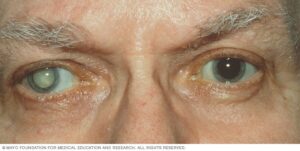Cataracts Explained

Cataracts Explained
Dr. Claire Arcidiacono, ND
I wanted to start off this topic on vision with cataracts for one simple reason – it’s extremely common. In fact I bet you know someone who has cataracts whether it be a relative or friend. Just how common are cataracts? Well according to the American Academy of Ophthalmology cataracts affect more than 20 million people age 40 and older! (1)
What exactly is a cataract? Well a cataract is when the lens of the eye goes from being clear to being cloudy. Basically as we age the lenses in our eyes become less flexible and clear and the proteins /fibers in the lens breakdown and clump together. Additionally the lens becomes thicker over time. All of these changes leads to the clouding of the lens. Over time the cataract will become larger and the clouding of your vision will become worse. One way to think of a cataract is to think of a fried egg. At first the “whites” are clear. As you cook the egg the whites go from clear and see through to opaque. That is exactly what happens to the lens of the eye! See attached picture for a comparison of a healthy eye and an eye with a cataract.

What are the most common risk factors for cataracts? One of the most common risk factors is age. Other risk factors include having a family history of cataracts, having a previous eye injury or eye inflammation and prior eye surgery. Life style factors such as excessive amounts of alcohol, smoking, being obese, getting too much sunlight and using corticosteroid medications all increase our risk. Lastly diabetes as well as myotonic dystrophy, galactosemia, neurofibromatosis type 2 or rubella are all risk factors for cataracts.
Now I bet you didn’t know that there is actually more than one type of cataract. The first type is called nuclear cataract which is in the center of the lens. Next is a cortical cataract which is on the edges of the lens. Then there is the posterior subscapular cataract which affects the back of the lens. Lastly some people can be born with cataracts or they develop in childhood. This is called congenital contracts.
Now moving ow what are the most common symptoms of cataracts. One of the first signs is cloudy, blurry or dim vision. You may need brighter lights for certain activities and you may have trouble seeing at night in general as well as a dimming of overall colors. You may also notice that you frequently require a change in eyeglass or contact prescription. You may see a “halo” around lights and even be sensitive to light. Lastly there may be double vision in 1 eye. Overall it’s important to see a doctor if you notice any changes in vision. (2)
What can you do about contacts? Well I’ll be honest once a cataract forms it can’t be dissolved. I mean remember the story about the fried egg? Once an egg is fried it can’t be un-fried. However studies do show a few things that can slow the growth of cataracts or reduce your risk factors for developing them. Let’s take a look at just what these things are, shall we?
- Life style factors that can help reduce your risk of a cataract include: wearing sunglasses, quitting smoking, reducing our alcohol consummation as well as eating healthy. If you have any chronic health concerns it is also important to address those. For example it is important to monitor and address your blood sugar if you have diabetes. The better the control you have over your diabetes the less of a risk factor you have. (3)
- Bilberry has been found in studies to help slow the progression of cataracts in up to 97% of people who used it! (4) Please see Invite’s Bilberry formula as well as our Macula Advanced!
- L Carnosine has been strongly associated with a reduction in risk of cataracts in those with diabetes. While more studies are needed it is a promising start. (5) Please see Invite’s L Carnosine Plus!
- Lutein and Zeaxanthin have been found in studies to have an inverse relationship with cataracts. What does that mean exactly? The more of these nutrients you consume the lower the rate of cataract formation. (6) Please see Invite’s Macula Advanced and Lutein Plus formula!
- Lycopene has been found to help reduce the rate of cataract formation. (7) Please see Invite’s extensive line of Multi vitamins as well as our Macula Advanced!
- Our next product highlight will be Grape Seed and how it relates to eye health!
Sources:
- https://www.aao.org/newsroom/eye-health-statistics#:~:text=A%3A%20Cataracts%20affect%20more%20than,Americans%20have%20had%20cataract%20surgery
- https://www.mayoclinic.org/diseases-conditions/cataracts/symptoms-causes/syc-20353790
- https://www.nei.nih.gov/learn-about-eye-health/eye-conditions-and-diseases/cataracts
- https://www.sciencedirect.com/topics/biochemistry-genetics-and-molecular-biology/bilberry#:~:text=It%20has%20been%20used%20in,20%25%20displayed%20progression%20of%20cataract.
- https://www.ncbi.nlm.nih.gov/pmc/articles/PMC5086400/#sec4title
- https://www.ncbi.nlm.nih.gov/pmc/articles/PMC6774801/#:~:text=Observational%20studies%20have%20demonstrated%20an,nuclear%20form%20and%20cataract%20surgery.
- https://pubmed.ncbi.nlm.nih.gov/12921892/#:~:text=Lycopene%20also%20reduced%20the%20incidence,with%20oral%20feeding%20of%20lycopene.
